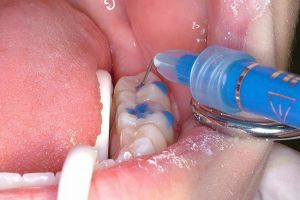 Chewing teeth, these are teeth-millstones for grinding food, having a special structure: their upper surfaces are formed by tubercles of broad-conical form.
Chewing teeth, these are teeth-millstones for grinding food, having a special structure: their upper surfaces are formed by tubercles of broad-conical form.
Where the bases of these gentle hills( similar to sand dunes on the seashore) converge, hollows-grooves of the most intricate shape pass between them.
They can be shaped like:
- funnel-shaped;
- polypoid;
- drop-like;
- is conical and has a depth of 0.25-3 mm.
Contents of
- Fissures - what is it and where is it?
- The destructive effect of the
- Fissure: caries was - and it's gone!
- Useful for children, recommended to adults
- Contraindications and limitations
- Selection of method and sealant
- Sealing of infant teeth - quickly and reliably
- Sealing permanent teeth
- Patients' opinion about procedure
- Service has a price
Fissures - what is it and where is it?
The logs between the dunes on the sea after each rainfall deepen, the leaking water leaves garbage in them, which gradually accumulates.
The grooves between the tubercles of molars change with time too. If initially they have a relatively small depth and a smooth rounded bottom, then gradually the sides of the tubercles begin to form an increasingly sharp and increasingly deeper corner.
And now the groove has turned into a small "ravine".If you look inside it, in the wider divergent sides of it you can see the thin layers of enamel in the cut.
This is the fissure - slit on the chewing surface of the molar tooth , more or less deeply dissecting its enamel. 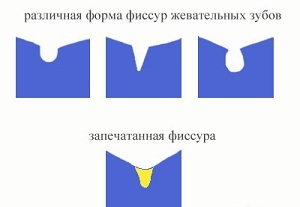 The literal translation of the word fissure from Latin: slit. Fissure in the tooth - this is not just a gap, it is a gap that "rolls" caries.
The literal translation of the word fissure from Latin: slit. Fissure in the tooth - this is not just a gap, it is a gap that "rolls" caries.
Its slit shape and sharp edge edges contribute to the accumulation of food residues in it.
With her everything, as with a real ravine: that the bottom of it got, then disappeared. Rather, it's rotten.
A decay means the expansion and deepening of the original innocuous little "gully-ravines".Because when decaying food residues, organic acids are always formed. And although they are very weak, they act on enamel around the clock.
The destructive effect of
The more fissures of food residues that can not be removed at the bottom, the more rapidly it deepens and expands, until in its deepest place a hollow-hole is formed through the entire thickness of the enamel, which continues to delve into the underlying tissues.
The path of saliva containing acids in the molars of molars is short and quickly leads to the formation of a ravine( fissure).
Fissura: caries was - and it's gone!
But if the usual ravine is just falling asleep and leveled, then it will not work with fissure. This "ravine" can not "fall asleep" to the top, as it is impossible and level "dunes" - the hillocks along its edges.
After all, if the surface of the molars make smooth and smooth, depriving them of these mini denticles, they will stop working - when chewing food will glide over a smooth surface, like on ice, and rubbing it will be impossible.
But it is safe to make a gap "ravine" safe, clearing it of decaying caries, "falling asleep" only partially and retaining the overall relief, it is quite possible. This operation is called sealing the fissures of the teeth.
Useful for children, recommended for adults
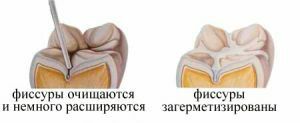 Common indications for sealing( for both children and adults) are fissures, which look like deep, narrow slits, inaccessible to their usual dental care.
Common indications for sealing( for both children and adults) are fissures, which look like deep, narrow slits, inaccessible to their usual dental care.
Fissures, already damaged by caries, can not be sealed-the caries stuck in the depths will continue to destroy the tooth( air access is not needed).
It is especially desirable to seal the fissures of teeth in children. After all, the process of mineralization of milk teeth takes a lot of time and it is necessary to have time to seal the fissures before the beginning of their defeat by caries.
On the same basis it is desirable to conduct fissure sealing in children soon after they have permanent teeth.
There are contraindications and limitations
Fissures, not damaged by caries for more than four years, do not need to be sealed.
To prepare the tooth for the procedure, it is necessary to clean the teeth and stone of all the teeth of the patient and to teach him how to keep the oral cavity clean.
The procedure is not performed if there is a lesion of caries of both the fissure itself and the tooth in general( including contact surfaces with adjacent teeth).
The choice of method and sealant
The meaning of the procedure is to prevent the penetration of a destructive infection into the bowels of the tooth, to the depths of its softer tissues than enamel.
Application of one of the two methods depends on the type of fissure - from the visual picture of its structure, confirmed by radiography:
- for open type non-invasive version is applied;
- for closed type is an invasive modification of the fissure sealing method.
With absolute assurance that there is no tooth decay in both the walls and the bottom of the fissure, non-invasive canning 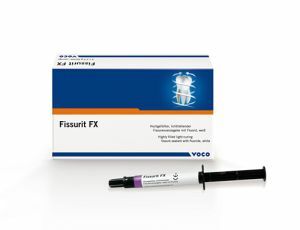 ( sealed sealing) of the cavity using a fluid-based light-cured sealant is used.
( sealed sealing) of the cavity using a fluid-based light-cured sealant is used.
When invasive techniques are used, closed-type fissures( deep and narrow) that are inaccessible to visual inspection, opening and expansion with a drill are first converted to open fissures and then sealed using the techniques of the first technique.
Perform the procedure using Fissurita F, Grandio Seal, giving the most dense( non-cavity) fissure filling due to the fluid-flow structure, which makes it easy to squeeze the hermetic from the syringe pen directly into the sealed area.
Sealants, represented by composite resins( filled or not filled) with a light or chemical curing mechanism, contain in their composition the optimal percentage of sodium fluoride for optimal tooth health( in Fissurite F it is equal to 3), and the mineralization of the tooth continues for another 12and more months after the procedure.
Sealing of infant teeth - quickly and reliably
Sealing of fissures in children in stages:
- begins the procedure with cleaning the tooth surface from plaque, then, dried, it is isolated from saliva;
- fissures are treated with a solution of orthophosphoric acid;
- tooth fissures, washed with distilled water, are filled with a liquid sealant( silant);
- silant is cured with a light curing light;
- the excess of the silant is removed, the surface of the tooth is ground.
The procedure takes from 5-10 to 45 minutes, is painless, protects the treated tooth from 5 to 10 years.
Seal permanent teeth
The recognition of fissure caries in permanent teeth in adults is often difficult: the fissure is often closed, deep or pigmented.
Given that the procedure is performed only on healthy( or decayed) teeth, apply invasive sealing with fissure grinding.
Stages:
- prior to the opening and expansion of deep and narrow fissures, their topography is refined by X-ray examination;
- the surface of the intended tooth is thoroughly cleaned with circular brushes using an abrasive paste;if necessary, resort to cleaning ultrasound or sandblasting machine;the tooth is thoroughly washed off the residue of the abrasive paste;
- for 15 seconds etched surfaces( fissures and adjacent areas) gel containing orthophosphoric acid;a thorough flushing and drying of the fissure surface is performed;
- squeezing out of the syringe-handle cavity is filled with a fluid-tight sealant with a uniform distribution in it, the excess of the silant is removed;
- after curing the silant with a light curing lamp, grind and polish the treated tooth surface.
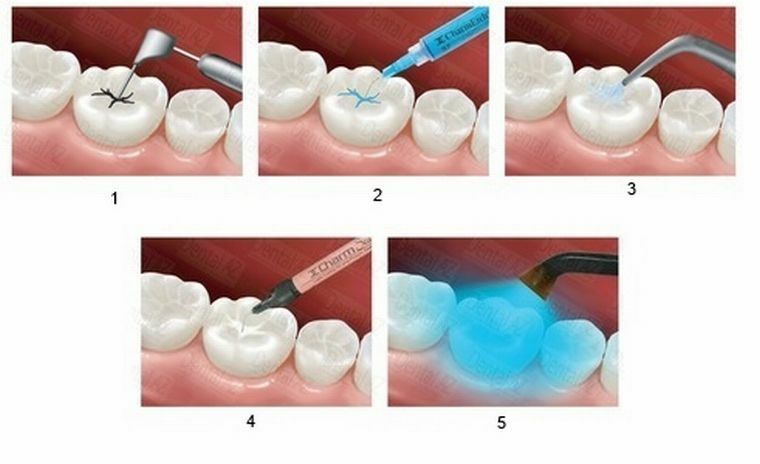
Opinion of patients about the procedure
Reviews of people who have been sealed fissures.
Carried the boy to seal the fissure of 4 milk teeth! I liked everything very quickly, and it looks more beautiful than silver.
Anastasia, 24( Voronezh)
Sealing I liked very much! !!It does not hurt at all, but very quickly. And I'm 8 years old!
Artem, 8 years old( Orel)
I read it in discussions, I decided to respond. After sealing two teeth has passed a year and a half - teeth are not hurt and not damaged.
Maya, 15 years( Astrakhan)
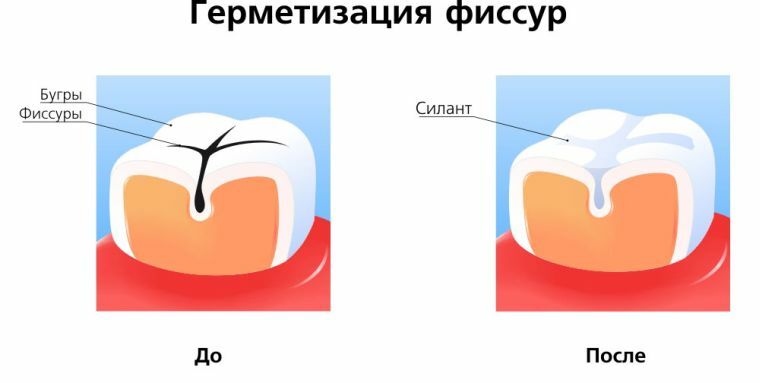
The service has a price
The price of sealing a fissure of one milk tooth depends on the volume and complexity of the surface being treated and is about 720 rubles.
According to the website of another dental clinic, the cost of sealing a single tooth is 600-900 rubles( when using a drill, the cost may be slightly higher).But( according to the data of the same site) this will cost the patient 2 to 3 times cheaper than the process of caries treatment.
Taking into account the cost of the methodology, it should be noted that it is commensurate with the value of the applied method( with the use of new composite materials, the method promises to become cheaper).
